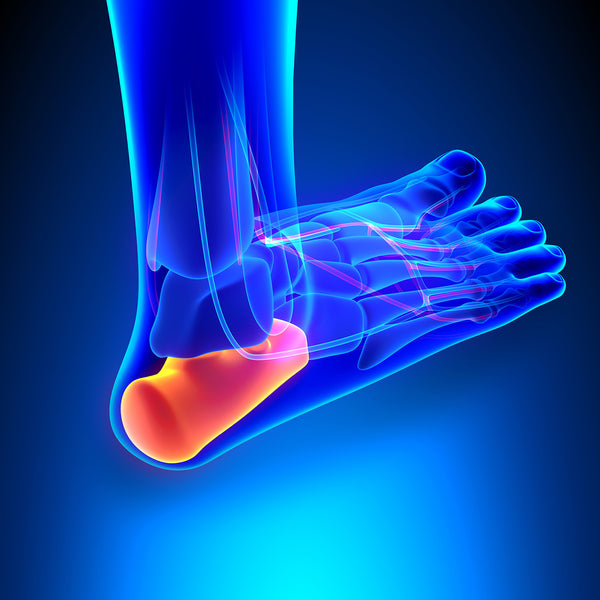Plantar Fasciitis: Causes, Symptoms, Treatment Options and Recovery

Plantar fasciitis, named after plantar fascia (toes), is one of the most common causes of heel pain. 1 in every 10 people is affected by plantar fasciitis at least once in their lives. It is common among people between the age group 40-60. It is caused by an inflammation in a thick band of tissues running across the bottom of the foot. This band of tissues connects your heel bone and toes. It is a common occurrence among runners and in people who are overweight. It is also more common among women than in men. Also, wearing shoes with inadequate support pose an increased risk of getting affected from plantar fasciitis.
Plantar Fasciitis – An Overview
Plantar fasciitis is the inflammation of your plantar fascia. Plantar fascia is a strong and thick band of tissues stretching from the heel to the bones of the middle foot. It provides support to the arch of your foot and also play the role of a shock absorber for your foot. Inflammation of the plantar fascia can be a painful condition and if left untreated, can cause serious problems for the foot. The symptoms of plantar fasciitis are worst when you wake up in the morning.
Causes of Plantar Fasciitis
The main cause of plantar fasciitis is a series of small repeated injuries in the plantar fascia. It can be accompanied with inflammation of the ligaments. The injury usually occurs near the point where your plantar fascia attaches to the heel bone. Plantar fasciitis is basically an overuse injury that is caused by repetitive stress to the same area of the foot that causes an overstretching of the plantar fascia. The plantar fascia becomes painful and inflamed due to the overuse at the attachment to the calcaneus. The condition traditionally was thought to be just inflammation but research has suggested that there is an absence of inflammatory cells and the most likely cause of the plantar fasciitis is degeneration of the fascia cells.
Here are the situations which can likely cause an injury to your plantar fascia:
- Being on your feet for a long time. It is also caused if you do lots of running, walking, standing etc. especially when you are not used to it and have been living a sedentary lifestyle previously
- If you have recently changed the surface you used for exercising, for example running on track instead of the road
- Wearing shoes that offer poor arch support and cushioning
- Being overweight puts an extra strain on your heel which can lead to plantar fasciitis
- Sudden stretching or continuous overuse of the sole. For example, increase in the running intensity by runners, poor technique etc.
- Having a tight Achilles tendon which affects the ability to flex your muscles in the ankle leading to more risk of damaging your plantar fascia
Plantar fasciitis is often confused with the problem of Policeman’s heel; however, they are different. There is often no apparent cause of plantar fasciitis among the older people.
The most common symptom of plantar fasciitis is pain in the underside of the heel. There is one main spot that is the main source of pain and is located about 4 cm in front of the heel. This spot is painful and tender to touch.
The pain associated with plantar fasciitis is worst when you take your first steps in the morning after waking up. Similarly, the pain is severe when there are long periods of inactivity and your foot has not borne any weight for a long time. While the pain may ease a little with gentle exercise throughout the day, being on your feet for a long time can make the pain worse. The pain is eased with resting your foot.
The pain becomes worse if there is a sudden stretching of the foot. Limping because of the pain is common. You can also have plantar fasciitis in both the heels at the same time.
Diagnosis of Plantar Fasciitis
Your doctor will be able to diagnose plantar fasciitis just by examining your feet. Tests are rarely needed to diagnose plantar fasciitis and are only done if there is an uncertainty about other causes of heel pain. The tests conducted for diagnosing plantar fasciitis include X-Rays and ultrasound scan of the foot. The ultrasound scan shows clearly if there is swelling and thickening in the plantar fascia or not.
Treatment Options
Recovering from plantar fasciitis may take a lot of time. There are surgical and non-surgical treatment options available for plantar fasciitis based on the severity of the condition and the extent of damage to the plantar fascia.
Non-Surgical Treatment Options
Resting your Foot: First things first, giving your foot proper rest is important to make it functional again. You should avoid running, standing, excess walking or any other activity that may cause the situation to aggravate. You can however do gentle walking and exercises. It is important to make use of mobility devices like knee scooters by KneeRover to make sure there is not extra weight put on your already injured foot. It is an ideal traditional crutch alternative and provide ease of movement without causing any pain in your arms, wrists, hands and underarms which is a common problem associated with traditional crutches.
Footwear: It is important to wear shoes with cushioned heels and the ones that provide good arch support. Do not wear old and worn out shoes and try wearing shows that provide laced support in contrast to open sandals.
Arch Supports and Heel Pads: Keeping these in your shoes at all times provide the much needed support to the heel and your entire foot. This raises the heel by 1 cm which is ideal to recover from plantar fasciitis. It is important to place these supports in both your shoes even if you have plantar fasciitis in just one foot.
Pain Relief Medications: To control swelling and pain, the doctor will give you pain relief and anti-inflammatory medications. You might also be given a gel or cream to rub on the affected area which helps in reducing swelling from the heel. The medications include
- Ibuprofen (Advil and Motrin)
- Tylenol (Acetaminophen)
- Naproxen (Aleve)
- Topical Creams
- Generic Aspirin
Exercises: Exercises are also suggested to relief the pain and loose the tightened muscles in your calves and feet as it can aggravate plantar fasciitis. Your physical therapist will suggest you the kind of exercise to help better your condition. Here are the exercises that can help in recovery from plantar fasciitis:
- Toe stretches
- Calf stretches
- Band or towel stretches
- Arch stretches
Injections: Cortisone injections are also a great option to reduce inflammation caused in plantar fasciitis. It is a strong anti-inflammatory steroid and is injected into the plantar fascia directly to control pain and inflammation. Having too many cortisone injections can lead it rupturing of the plantar fascia, chronic pain and flat feet, therefore, care must be taken when using them.
Night Splints: It is important to keep the plantar fascia stretched while you are sleeping. The best way to do it is wearing night splints such as Strassburg sock. It might take some time to get used to it, but can help in alleviating pain.
Surgical Treatment Options
When the non-surgical treatment options do not work, the last resort available to the doctors is to conduct a surgery. These are only considered after a year of non-surgical treatment with no apparent positive results.
Gastrocnemius Recession: During this procedure, doctors lengthen one of the two calf muscles which increase the ankle motion. While there are not many complication associated with this surgical procedure, yet in some cases incision infection and nerve damage have been reported.
Plantar Fascia Release: To relieve tension from the tissues and ligaments of your feet, doctor partially cuts the plantar fascia ligament in your foot. The surgery involves a small incision when performed endoscopically.
Complications
Nerve damage and incomplete relief from pain are the common complications associated with these surgical procedures. However, most patients have positive results. You will be instructed by the doctor to rest your leg post-surgery. It is important to keep the leg non-weight bearing by using knee scooter or knee walker from KneeRover.
Preventing Plantar Fasciitis
Here are some tips that can help you in preventing plantar fasciitis:
- Landing on your middle foot evenly when walking and more importantly when running
- Relaxing your lower legs
- Avoiding pulling yourself forward and letting your upper body lead you. Your legs will follow suit
- Avoiding uneven surfaces when running
- Avoiding stairs whenever possible
Plantar fasciitis may be quite painful but it is a common and manageable condition. It can take several months to heal properly. It is important to listen to your feet and body whenever they give you a signal. If you feel there is a constant sharp pain in your heel, make sure you visit a doctor.
This is for informational purposes, please remember to visit and consult with your doctor for any medical advice and treatment.
Looking for a knee scooter or knee walker? Whether you are looking for a knee scooter rental or a knee scooter for sale, we have the best option for you. Purchasing a knee scooter can be more cost effective than renting a knee scooter. Can't find a knee scooter near me? We offer free next day shipping!

